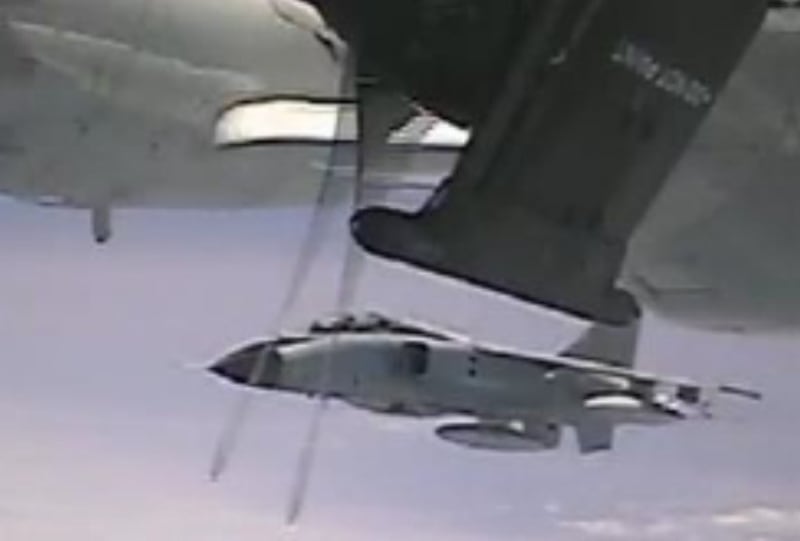The United States has accused the Chinese military of carrying out “a centralized and concerted campaign” to prevent U.S. forces from operating safely in the air and in the sea.
The Department of Defense (DoD) released photos and video clips on Oct. 17 documenting 15 cases of what it calls China's "coercive and risky operational behavior" against U.S. aircraft in the East China and South China seas in the last two years.
"Since the fall of 2021, we have seen more than 180 such incidents – more in the past two years than in the decade before that," Assistant Secretary of Defense for Indo-Pacific security affairs Ely Ratner told reporters at a press briefing at the Pentagon.
“And when you take into account cases of coercive and risky PLA [People’s Liberation Army] intercepts against other states, the number increases to nearly 300 cases against U.S., allied and partner aircraft over the last two years,” he said.
Ratner pointed to “a centralized and concerted campaign to perform these risky behaviors in order to coerce a change in lawful U.S. operational activity and that of U.S. allies and partners” that represents “a significant concern.”
Commander of U.S. Indo-Pacific Command Navy Adm. John Aquilino, meanwhile, said that all his requests to speak with Chinese counterparts in the last two and a half years have been refused.
The two officials spoke ahead of the upcoming release of the DoD’s Chinese Military Power Report.
A day earlier, U.S. ally Canada accused China of conducting a "dangerous and reckless" interception of a Canadian surveillance aircraft over the East China Sea. Beijing responded by saying the Canadian plane "intruded into Chinese airspace."
3 meters below U.S. plane
The declassified images and videos show a pattern of aggressive behavior by the Chinese military aircraft.
In an incident dated May 24, 2022, a PLA fighter jet, likely a Chengdu J-10, “first sped toward the U.S. asset and crossed under the plane’s nose, causing the U.S. aircraft to lose visual contact of the PLA fighter,” the DoD said.
“After the U.S. pilot opened some distance between the two planes, the PLA pilot re-approached at a distance of just 15 feet (4.572 meters) laterally and 10 feet (3.048 meters) below the U.S. plane.”

A fortnight later, on June 8, 2022, four PLA airplanes conducted an intercept over the course of five hours, including by approaching a distance of just 12 meters and taking pictures of the U.S. plane.
Besides reckless maneuvers and close approaches at high speeds in the air, or “buzzing,” Chinese aircraft also released “objects and projectiles like flares.”
On June 23, 2022, a PLA Su-30 jet was recorded repeatedly flying above and below a U.S. aircraft and “flashing its weapons.”
“After the U.S. operator radioed the PLA fighter jet, the PLA pilot responded using explicit language, including an expletive,” the DoD said.
Adm. Aquilino said that U.S. and Chinese planes “have been flying much closer together” since a 2001 incident when a U.S. Navy EP-3E Aries II aircraft collided midair with a Chinese F-8 fighter jet over the South China Sea.
“When you get to unsafe and unprofessional, that’s really concerning behavior. People’s lives are at risk,” said the commander of the U.S. Indo-Pacific Command.
“In other words, flying off my wing at 15 feet (4.572 meters) for 45 minutes has too much of a chance to lead to an accident. We’ve seen an increase in those close intercepts and activities in very close proximity to our airplanes,” he said.
Separately, Assistant Secretary of Defense Ely Ratner said the Chinese intercepts are not limited to the skies but “throughout domains and throughout geographies.”
Chinese ships have reportedly harassed U.S. and allied warships in the East China Sea and the South China Sea.
“We’re seeing it on land against our Indian partners,” Ratner said, “This is part of a much broader picture.”
China has yet to respond to the newly released images but Beijing has always maintained that “in most areas and cases, the Chinese military follows and monitors the situation based on international practice.”
A well-known Chinese analyst, Hu Bo, wrote in the South China Sea Probing Initiative website that "different regions have different legal and political meanings for both sides," implying that the PLA merely reacted to U.S. intrusions.
Edited by Taejun Kang and Elaine Chan.
